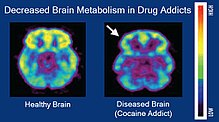Addiction
| Bayanai | |
|---|---|
| Ƙaramin ɓangare na |
hali, health problem (en) |
| Karatun ta |
addictology (en) |

Addiction cuta ce ta neuropsychological wacce ke da tsayin daka da matsananciyar sha'awar shiga wasu mummunan halaye marasa kyau, ɗayansu shine amfani da magani, duk da cutarwa da sauran sakamako mara kyau. Maimaita amfani da miyagun ƙwayoyi sau da yawa yana canza aikin kwakwalwa ta hanyoyin da ke dawwamar sha'awa, kuma yana raunana (amma baya hanawa gaba ɗaya) kamun kai.[1] Wannan al'amari-kwayoyi da ke sake fasalin aikin kwakwalwa-ya haifar da fahimtar jaraba a matsayin rashin lafiyar kwakwalwa tare da nau'i-nau'i iri-iri na psychosocial da kuma neurobiological (kuma ba tare da son rai ba) abubuwan da ke da tasiri a cikin ci gaban jaraba. Alamu na al'ada na jaraba sun haɗa da tilastawa cikin abubuwan motsa rai, shagaltuwa da abubuwa ko ɗabi'a, da ci gaba da amfani duk da mummunan sakamako. Halaye da tsarin da ke da alaƙa da jaraba galibi ana nuna su ta hanyar gamsuwa nan da nan (lada na ɗan gajeren lokaci), haɗe tare da jinkirin lalacewa (long-term cost).
Misalai na miyagun ƙwayoyi (ko fiye da gabaɗaya,) jaraba sun haɗa da shan barasa, jarabar shan marijuana, jarabar shan amphetamine, jarabar shan cocaine, jarabar shan nicotine, jarabar shan opioid, da ci ko jarabar cin abinci. A madadin, jarabar ɗabi'a na iya haɗawa da jarabar yin caca, jarabar intanet, jarabar yin wasan bidiyo, jarabar batsa da jarabar jima'i. Iyakar jarabar ɗabi'a da DSM-5 da ICD-10 suka gane shine jarabar caca. Tare da ƙaddamar da jarabar wasan ICD-11 an haɗa.[2]

Ana yawan amfani da kalmar "jaraba" yayin da ake magana akan wasu halaye na tilastawa ko cuta, musamman dogaro, a cikin kafofin watsa labarai. Bambanci mai mahimmanci tsakanin jarabar miyagun ƙwayoyi da dogaro shine cewa dogaro da miyagun ƙwayoyi cuta ce wacce ta daina amfani da miyagun ƙwayoyi yana haifar da rashin jin daɗi na janyewa, wanda zai haifar da ƙarin amfani da miyagun ƙwayoyi.[3] Addiction shine tilasta yin amfani da wani abu ko aiki na wani hali wanda bai dace da janyewa ba. Addiction na iya faruwa idan babu dogaro, kuma dogaro na iya faruwa idan babu jaraba, kodayake su biyun suna faruwa tare.
Manazarta
[gyara sashe | gyara masomin]- ↑ Nestler EJ (December 2013). "Cellular basis of memory for addiction". Dialogues in Clinical Neuroscience. 15 (4): 431–443. PMC 3898681. PMID 24459410. Despite the importance of numerous psychosocial factors, at its core, drug addiction involves a biological process: the ability of repeated exposure to a drug of abuse to induce changes in a vulnerable brain that drive the compulsive seeking and taking of drugs, and loss of control over drug use, that define a state of addiction. ... A large body of literature has demonstrated that such ΔFosB induction in D1-type [nucleus accumbens] neurons increases an animal's sensitivity to drug as well as natural rewards and promotes drug self-administration, presumably through a process of positive reinforcement ... Another ΔFosB target is cFos: as ΔFosB accumulates with repeated drug exposure it represses c-Fos and contributes to the molecular switch whereby ΔFosB is selectively induced in the chronic drug-treated state.41 ... Moreover, there is increasing evidence that, despite a range of genetic risks for addiction across the population, exposure to sufficiently high doses of a drug for long periods of time can transform someone who has relatively lower genetic loading into an addict.
- ↑ Nestler EJ (December 2013). "Cellular basis of memory for addiction". Dialogues in Clinical Neuroscience. 15 (4): 431–443. PMC 3898681. PMID 24459410. Despite the importance of numerous psychosocial factors, at its core, drug addiction involves a biological process: the ability of repeated exposure to a drug of abuse to induce changes in a vulnerable brain that drive the compulsive seeking and taking of drugs, and loss of control over drug use, that define a state of addiction. ... A large body of literature has demonstrated that such ΔFosB induction in D1-type [nucleus accumbens] neurons increases an animal's sensitivity to drug as well as natural rewards and promotes drug self-administration, presumably through a process of positive reinforcement ... Another ΔFosB target is cFos: as ΔFosB accumulates with repeated drug exposure it represses c-Fos and contributes to the molecular switch whereby ΔFosB is selectively induced in the chronic drug-treated state.41 ... Moreover, there is increasing evidence that, despite a range of genetic risks for addiction across the population, exposure to sufficiently high doses of a drug for long periods of time can transform someone who has relatively lower genetic loading into an addict.
- ↑ "Drugs, Brains, and Behavior: The Science of Addiction – Drug Misuse and Addiction". www.drugabuse.gov. North Bethesda, Maryland: National Institute on Drug Abuse. 13 July 2020. Retrieved 23 December 2021.
